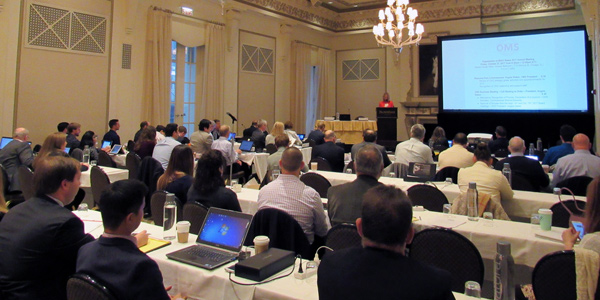By Amanda Durish Cook
CHICAGO — The Organization of MISO States (OMS) last week failed to reach consensus on how to respond to MISO’s plans to allocate costs for smaller transmission projects that produce broader economic benefits for the grid.
OMS is slated to present its suggestions on cost allocation at a Nov. 16 Regional Expansion Criteria and Benefits Working Group (RECBWG) meeting, but members were still unable to develop a unified position during their annual meeting on Oct. 27. OMS set a priority to establish a group position on the subject late last year. (See No OMS Consensus on MISO Cost Allocation Changes.)
MISO currently has no mechanism in place for allocating costs for economic projects with voltage ratings below 345 kV.
OMS board members say they might ask MISO to require market efficiency projects to be at least 230 kV and have a cost threshold of either $1 million or $5 million to $20 million in order to be eligible for cost allocation. They could also request that the benefit-cost ratio be increased from 1.25:1 to 1.5:1 if benefits other than the adjusted production cost are factored in, a move MISO has promised to consider.
The RTO has meanwhile assembled a straw proposal that would lower the cost allocation eligibility threshold to 100 kV, replace the 20% footprint-wide allocation with a postage stamp rate and enact a still unspecified project cost threshold. The proposal would limit cost allocation to benefiting transmission pricing zones.
Missouri Public Service Commission economist Adam McKinnie said his state requires a voltage threshold below 230 kV. “The interconnections between my state are 161 kV [or] 169 kV. I’m very wary of any cost allocation that does not give lower-voltage projects between SPP and MISO a cost allocation,” he said.
North Dakota Public Service Commissioner Julie Fedorchak expressed discomfort with any proposal that would allocate 100% of costs to benefiting transmission pricing zones, pointing out that much of the transmission development occurring in her state will not necessarily benefit its ratepayers.
The OMS board has also contemplated a cost-sharing proposal that would designate one portion of costs to benefiting transmission pricing zones and another to the local resource zones that contain those pricing zones.
“I think this debate shows that regulators need time to go back to their states and digest this,” said OMS President Angela Weber.
“Every state might not get everything they want, but the question is, ‘Can we come up with something that is better than what MISO is proposing?’” said Public Utility Commission of Texas staffer Werner Roth.





